Starlink Satellite vs Fiber: Which Internet Service Meets Your Needs?
Starlink vs. Fiber Internet for rural Alberta? Discover the best high-speed internet solution to meet your needs in rural Alberta areas.
Starlink vs. Fiber Internet for rural Alberta? Discover the best high-speed internet solution to meet your needs in rural Alberta areas.
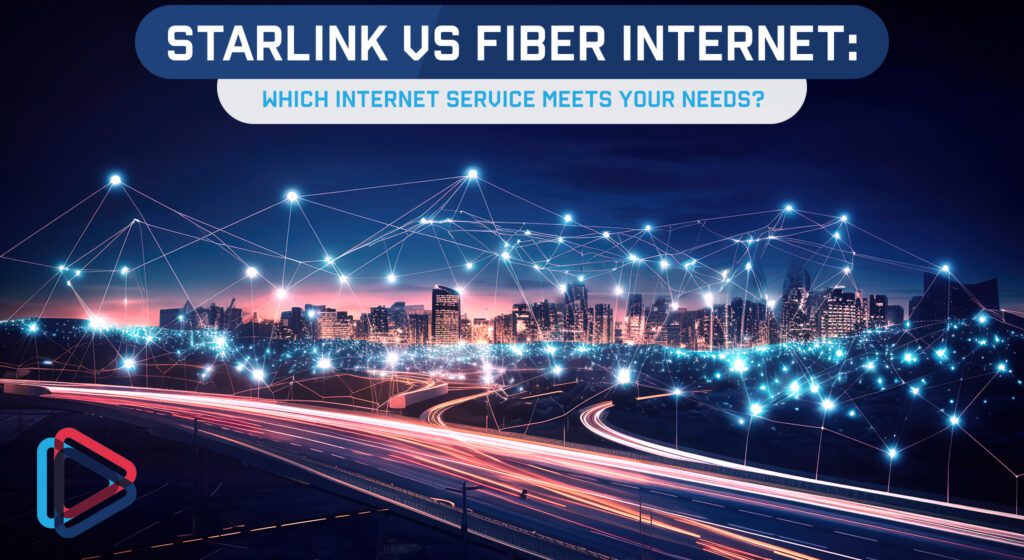
When it comes to rural Alberta internet, two main internet types are often in the ring together: satellite vs fiber optic internet.
And rightfully so! Both options are excellent solutions for rural Albertans to get the high-speed internet of their dreams, regardless of how remote they are. But which one is better, and why?
Satellite internet, with its seemingly unlimited range, promises coverage to even the most secluded rural areas. Fiber optic, with its blazing-fast speeds and direct-to-home connection, appears to be the clear choice for reliability when compared to Starlink internet speed.
Both options present rural Albertans with some decisions: The expansive reach of satellite or the unrivalled speed and reliability of fiber? DIY install or leave it to the pros? Local support or international queues?
We know this choice can be tricky, which is why we’ve created this guide to help you navigate your decision and, ultimately, make the best choice for you.
Before we can begin to determine which service is best for you, we’ll begin by discussing the pros and cons of each. Let’s jump in!
Satellite internet and its wide availability transformed the landscape of internet in rural and remote locations. By tapping into not one, but an entire network of satellites that orbit the Earth, internet providers can get their services to (almost) anywhere on Earth.
This process begins when a ground station sends an internet signal to a satellite. The satellite, from its high vantage point, can then send the signal down to satellite dishes. By beaming the signal down from space, the ground station can get the signal to homes in a way it otherwise couldn’t on the ground (with obstructions like buildings and mountains in the way).
For folks in rural Alberta, satellite internet has been breaking down barriers of remoteness, rough terrain, a lack of towers, and more. It opens up a realm of possibilities and reduces digital isolation.
The installation process for satellite internet is relatively straightforward, but can often require a DIY installation, affecting Starlink cost. It involves setting up the dish, ideally in a location with a clear view of the sky with no trees or other obstructions in the way. The dish is then connected to a modem inside the user’s home, providing the Wi-Fi signal.
Starlink Internet: Where It Stands Today
Recent advancements in satellite technology have been groundbreaking, to say the least. Modern satellites are equipped with higher capabilities and more sophisticated technology, improving speeds and reliability.
SpaceX launched Starlink satellites in 2019. This satellite internet provides coverage to over 60 countries, and as of November 2023, consists of over 5,000 satellites.
Unlike traditional satellites, which operate some 22,000 miles above Earth, Starlink satellites are in low orbit, around 300 miles above Earth, which results in faster Starlink internet speeds. This means that Star link internet speed is considerably faster than traditional satellite, and reliability is improved with less distance to cover.
In summary, satellite internet is a great way for most rural Albertans to connect to the internet, overcoming geographical challenges presented by other internet options.
But is Starlink internet faster than fiber optic? The answer: no. In fact, it’s not even close. Let us explain.
Fiber optic internet stands head and shoulders above all other internet services when you’re talking high speeds. But why is that?
Fiber optic is cutting-edge technology, harnessing the power of fiber optic cables that are only slightly thicker than a strand of hair. These cables rely on light signals to send data, so they’re capable of transmitting data at the speed of light. No, seriously.
It’s not just speed that sets this service apart from the rest. Fiber optic cables are connected directly to your home, often underground, meaning your internet signal has unmatched reliability. No need to worry about a heavy storm or other obstruction impacting your internet signal!
However, fiber internet comes with its own set of challenges, particularly in the landscape of rural Alberta. When setting up the infrastructure required for this service, extensive planning and digging are required to lay the cables.
In rural Alberta – where you have to navigate rough terrain like mountains, forests, and rivers – this isn’t always possible. Additionally, the cost and disruption from this process may not be worth it in sparsely populated areas.
Despite these challenges, the benefits of fiber optic internet are undeniable. With unparalleled speed and reliability, it offers a seamless internet experience and the ability to handle multiple users at the same time.
Now that we’ve explained each service, along with some key pros and cons, let’s get into some key considerations to help you make this decision.
You know the difference between satellite internet and fiber optic, but which one is better for you? In this section, we compare and contrast Starlink satellite with MCSnet fiber optic internet.
Although MCSnet fiber optic speeds are the clear winner in this category, Starlink speeds in Alberta are impressive for satellite internet. From their website, Starlink states that users in Alberta will typically experience download speeds between 43 and 138 Mbps, and upload speeds between 5 and 20 Mbps.
Starlink has a larger-than-life goal of offering users 10 Gbps (10,000 Mbps!) in the coming years, as part of Elon Musk’s vision. However, data shows this may be a lofty goal: as more users sign up for Starlink, average speeds are dropping. In Canada, typical Starlink speeds halved from approximately 120 Mbps in late 2021 to 60 Mbps in mid-2022.
Contrast that with MCSnet fiber optic service and you’ll find a very different story. For the same cost as a basic Starlink plan, our Fiber 1000 plan offers top download and upload speeds up to 1000 Mbps, with typical users experiencing guaranteed speeds as presented: 1,000 Mbps down and up.
Latency, defined as the time it takes for your internet to get from your provider source to you, is a critical factor when evaluating an internet plan. If you have high speeds but suffer from high latency, you won’t end up experiencing those high speeds.
For example, if you’re a gamer, high latency can translate to lag. If you’re working from home on a video call, high latency can mean buffering or, at worst, dropped calls.
As Starlink uses satellites, latency can be higher, especially on days with heavy precipitation. Starlink reports 47-64 milliseconds of average latency for the Alberta service area, with even higher numbers across Northwestern Saskatchewan
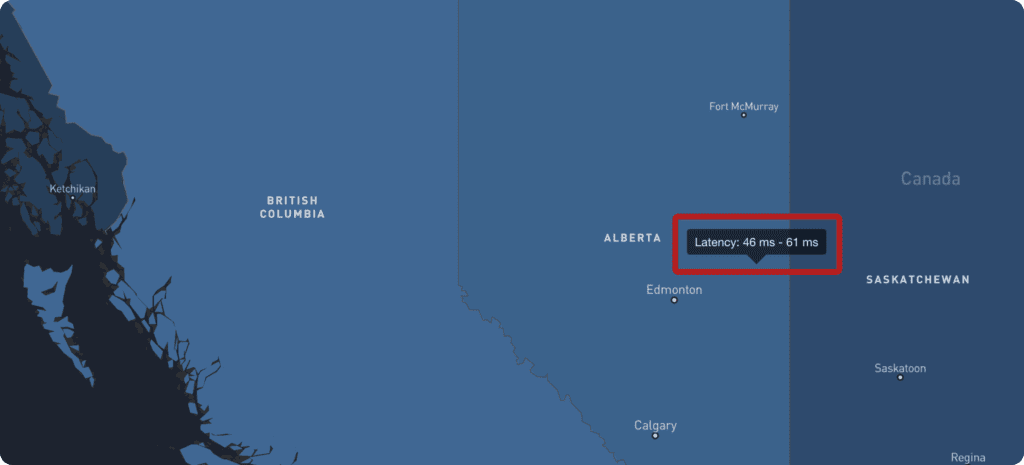
MCSnet fiber, because it’s connected directly to the home, has much lower latency – only 30 milliseconds on average. This means that very little data is lost on its way to your home, allowing you to experience the full speeds of your plan.
Uptime is a metric that measures your internet’s reliability and stability, usually written as a percentage of time that your internet is continuously connected. A higher uptime means better reliability!
Fiber-to-the-home (FTTH), as with MCSnet fiber optic, offers approximately 99% uptime to customers (Khalil et al., 2022). However, MCSnet fiber customers may experience even better uptime. This is due to something called Active Optical Network (AON).
The use of AON basically means that we provide a direct and personal internet connection to each customer. Some other fiber providers use Passive Optical Networks (PON), meaning their fiber customers share a fiber connection, making it slightly more susceptible to latency.
Not only does this provide better reliability to our customers, but it enables us to deliver a dedicated 1 Gbps connection to each home!
Here’s a diagram showing how Fiber Optic networks function to deliver consistently high speeds.
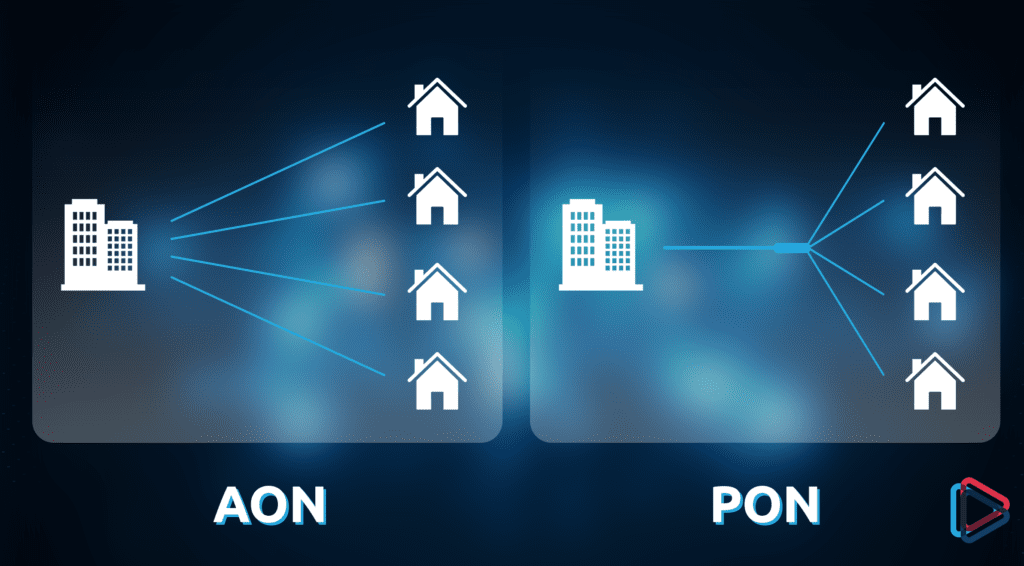
While Starlink doesn’t share its average uptime, certain factors that can impact reliability on any satellite internet service are still present. These can include heavy precipitation, uneven load on certain satellites, and peak-time interruptions.
So, what does all of this data mean for you?
While Starlink certainly has the edge for availability in this competition, the numbers for speed, latency, and uptime can vary drastically due to factors out of your control. Weather, number of users, number of satellites, signal interference, and more can all impact your experience with Starlink.
Conversely, with MCSnet’s fiber packages, you know exactly what speeds, latency, and reliability you’re receiving. Your speeds are fixed, the latency is low, and your internet signal won’t be affected by even the harshest weather conditions.
To help stack fiber and satellite up for easy comparison, here are all the categories we’ve mentioned to this point:

If you’re ready to view our fiber packages, check them out here. If you want to continue with us on our comparison breakdown, we’re going to get into outages and support next!
When it comes to managing any potential issues or outages that may arise, MCSnet and Starlink have two very different approaches and options for customers.
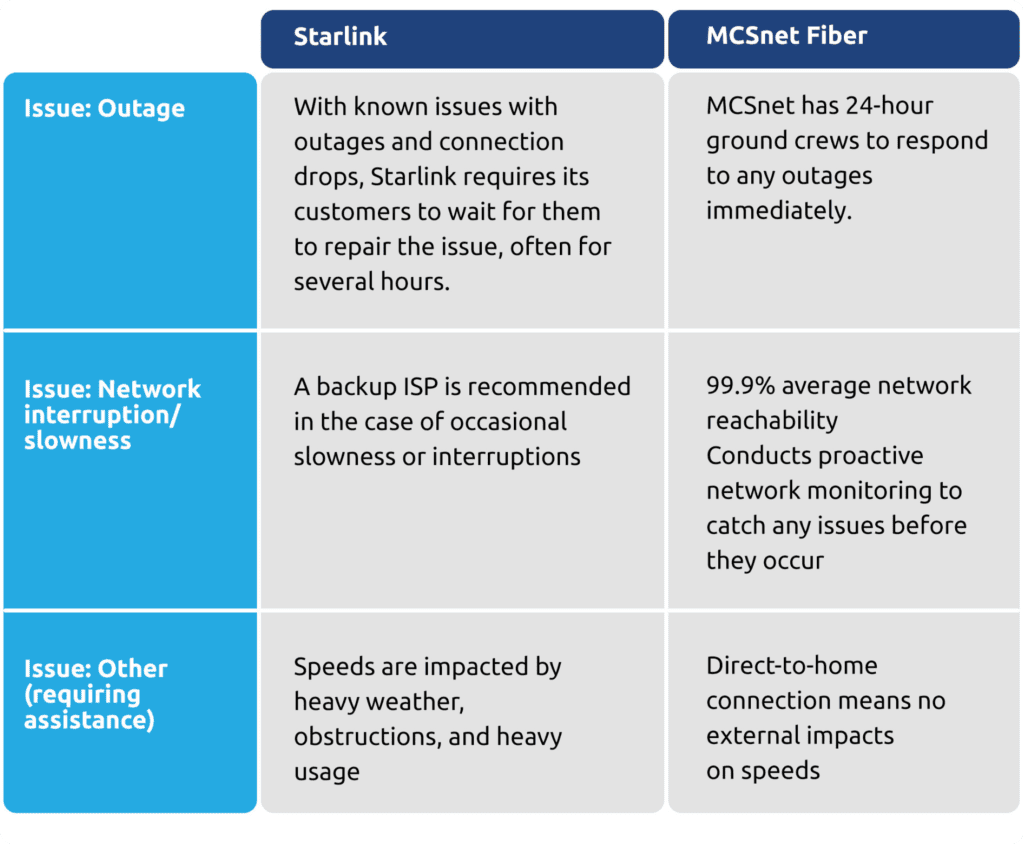
In summary, while both fiber and Starlink are transforming internet access in rural Alberta, the reality is that both options offer different levels of customer service and network management. MCSnet’s fiber provides a more reliable and stable service, with better customer service. Starlink, while innovative and with impressive reach, still grapples with the challenges of satellite internet and a worldwide customer base.
We know that cost is a critical factor when deciding on the right internet plan. When considering the cost between fiber and Starlink, it’s important to not just examine the up-front cost and monthly fee, but also the flexibility and structure of the plans.
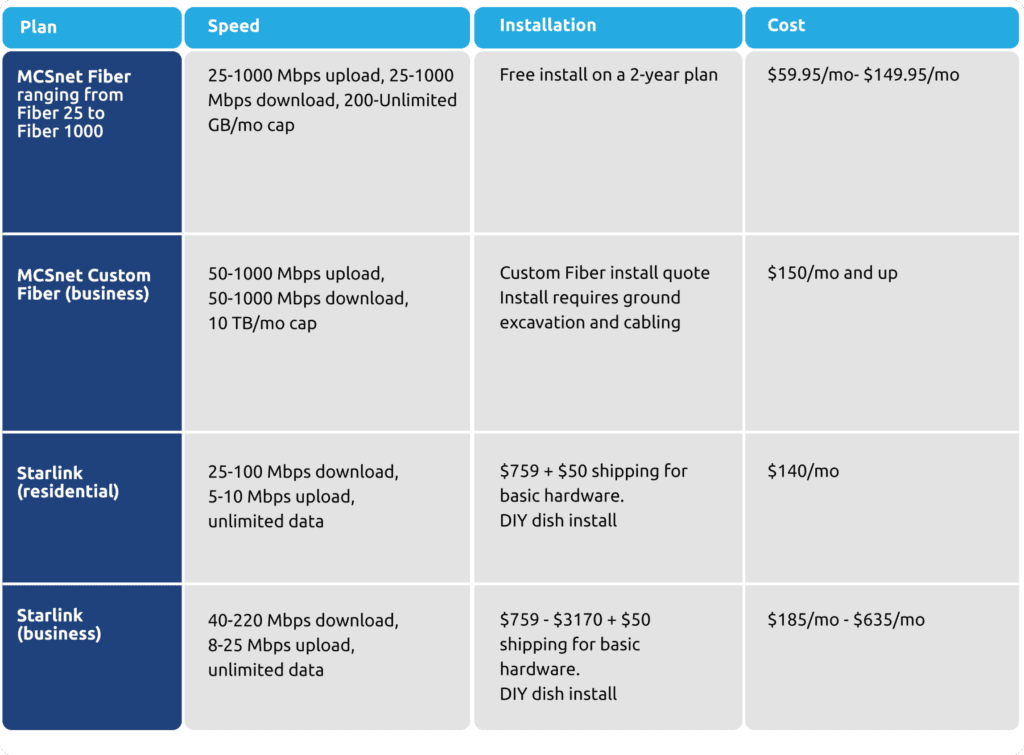
Fiber plans have a variety of options, offering customers a plan that will surely fit within their budget and needs. Additionally, businesses have separate pricing options for their unique needs, and receive extra customizability when deciding on the right plan for them.
Starlink’s plans, while pricier, offer more flexibility. Starlink offers a 30-day trial period to customers before fully committing. Neither MCSnet fiber nor Starlink require customers to sign a contract, so you’re not locked into a term if you decide it’s not for you.
As you can see in this chart, Starlink customers are required to do their own installation, whereas fiber customers don’t need to lift a finger. We’ll get into that more next.
If you’re relatively handy, and the concept of installing your own satellite dish doesn’t turn you into an anxious wreck, Starlink could be a great choice for you. If this thought isn’t an option for you, fiber is the route to take.
When you opt for fiber, trained technicians will come and do the complete installation for you, start to finish. One downside to this option is that fiber is not readily available in every location.
But keep in mind that this DIY support tactic doesn’t end at installation – Starlink will require you to search their forum for answers if you have an issue, and if still unresolved, will require you to submit a support ticket. MCSnet fiber customers get access to our phone number which is answered by real people at our St. Paul office – no machines here!
If you’re not someone who puts a ton of emphasis on customer service, we’ll head into our final area of consideration for you as you make this decision: additional features and monthly services.
While both MCSnet fiber and Starlink plans offer flexibility with month-to-month contracts, they differ in some additional features that may push you in one direction or another.
Global Availability
If you’re someone who travels often and wants to get internet everywhere you go, Starlink is the way to go. With Starlink’s Roam plan and hardware, you can take your dish with you and connect to the internet almost anywhere on Earth (even in the middle of the ocean!), which is a key Starlink feature.
With Starlink Roam, no matter where in the world you are, you can say goodbye to data roaming charges. However, this plan is certainly pricier, with Starlink Roam Global plans starting at $200 per month.
If the decision wasn’t challenging enough between Starlink and fiber optic internet options, another contender has recently entered the rural Alberta internet game: GigAir gigabit internet.
GigAir internet works similarly to fiber optic and therefore offers the same blazing-fast speeds. Fiber optic cable brings data to a tower in a community, which projects the signal out to various “nodes” around the community. These nodes amplify the signal and distribute it around the community.
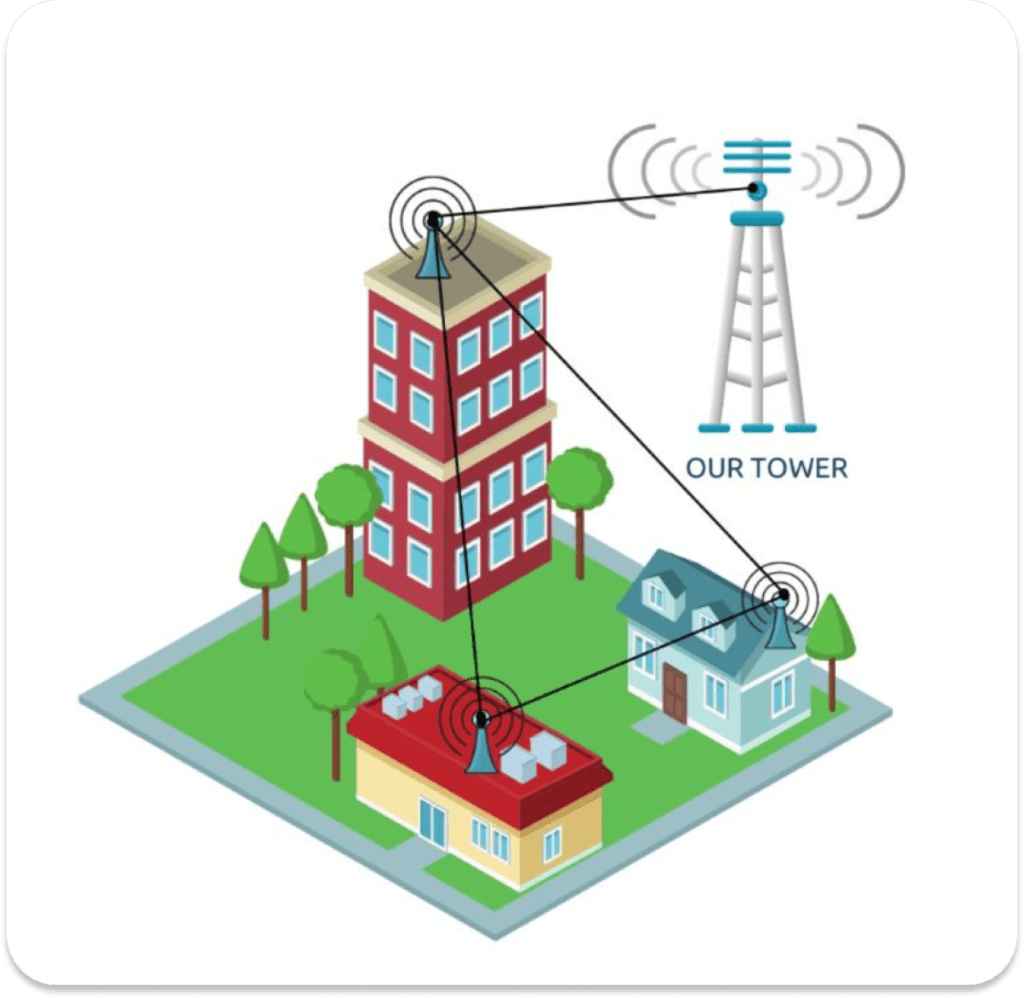
Let’s compare GigAir internet to Fiber and Star Link:

GigAir is an amazing alternative for those who want to opt for fiber speeds and reliability, but may not be in an eligible area just yet. GigAir is less expensive than fiber, offers wider coverage, and has a much simpler install (no need to worry about excavating your property!).
To view our GigAir plans, click here.
Is Starlink internet faster than fiber optic internet? No.
While both have their strengths and weaknesses, fiber optic internet is the best choice for speed, reliability, and cost. But that doesn’t mean Star link and other satellite internet options don’t play an important role in connecting all Albertans to the internet if they are remote or don’t have the option of fiber optic or gigabit internet.
If you want to experience fiber optic speed and reliability but for a more affordable price, GigAir is a great way to do this. By leveraging fiber optic technology in a mesh network, GigAir will ensure you can game, watch, surf, and stream seamlessly.
To sign up today for fiber speeds with GigAir, click here.
With faster speeds, better reliability, lower latency, and better affordability, fiber internet is the better choice for rural Albertans. Satellite internet, however, provides wider coverage, so it makes a great option for the most remote Albertans who may not be eligible for fiber internet.
Is satellite internet worth it?
Satellite internet has its pros, especially in remote areas where other internet options aren’t available. Satellite internet, though not as fast or reliable as fiber, still offers reasonable speeds.
Though Starlink has a lofty goal of bringing 10 Gbps speeds to users, currently, Starlink’s top speed for residential users is 100 Mbps. Fiber can reach up to 1 Gbps (1000 Mbps), making fiber the clear winner.
Just like in the comparison between Starlink and fiber, Starlink has the edge over 5G when it comes to availability. 5G service is limited to locations with cable tower infrastructure, whereas Starlink can reach even the most remote areas. 5G, however, can reach higher speeds with lower latency, so the choice depends on individual needs.
Both Starlink and fiber have a place in rural Alberta internet options. Installing fiber infrastructure can be nearly impossible in some of rural Alberta’s rough, mountainous terrain, giving Starlink the edge. Ultimately, we want to see all Albertans connected to the internet, which means that Starlink and fiber can coexist and service different customers.
No. While Starlink satellite internet is certainly an improvement from traditional satellite internet, it still suffers from latency issues due to distance and obstructions for the signal. Fiber, on the other hand, relies on a direct-to-home connection, so there is less latency.
Thanks for visiting! We hope that you have found what you needed on our website. If not, please feel free to contact us using this form and we will get back to you within one business day. Tech support hours are 6:00 AM to 10:00 PM, 7 days a week.